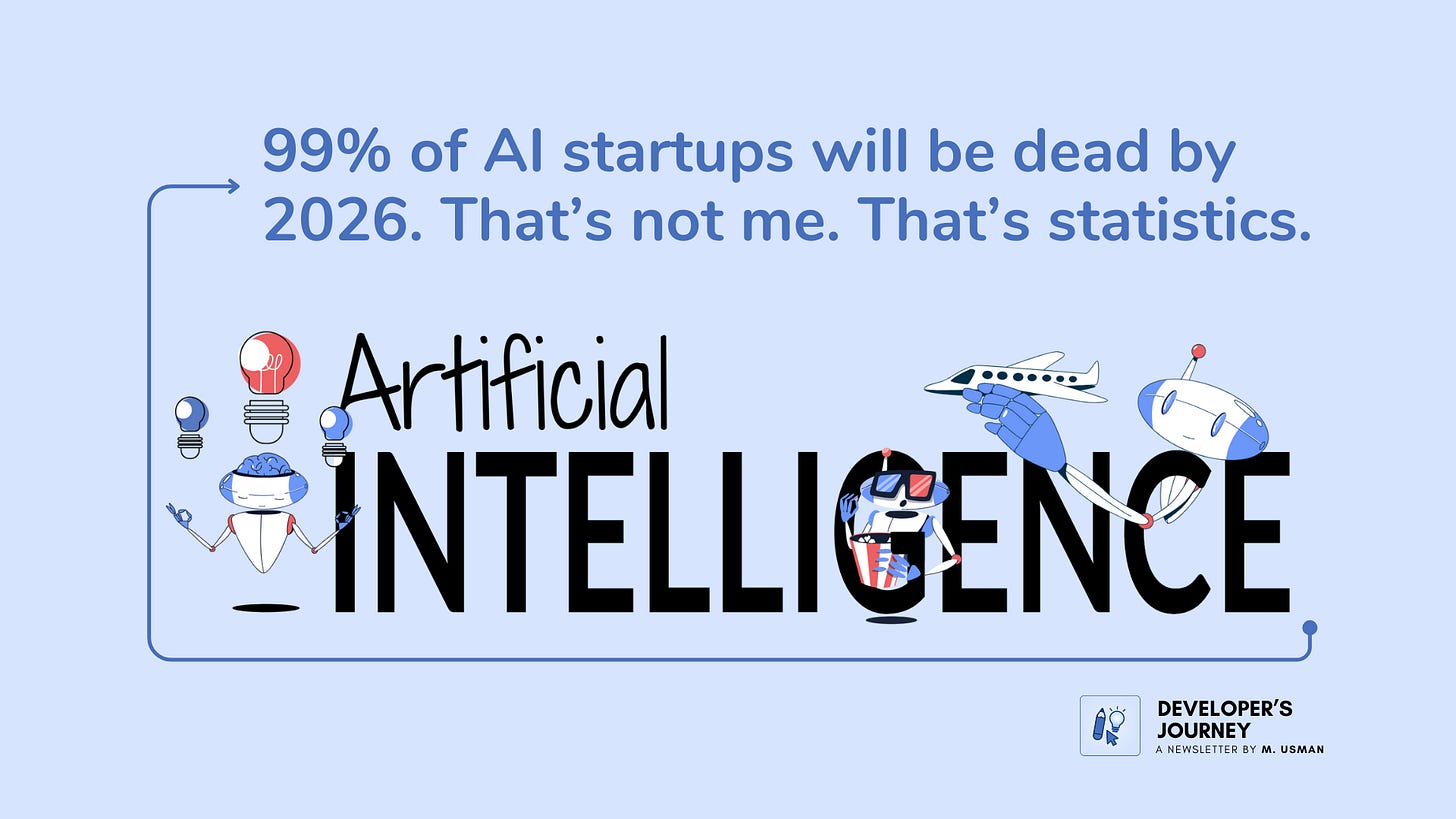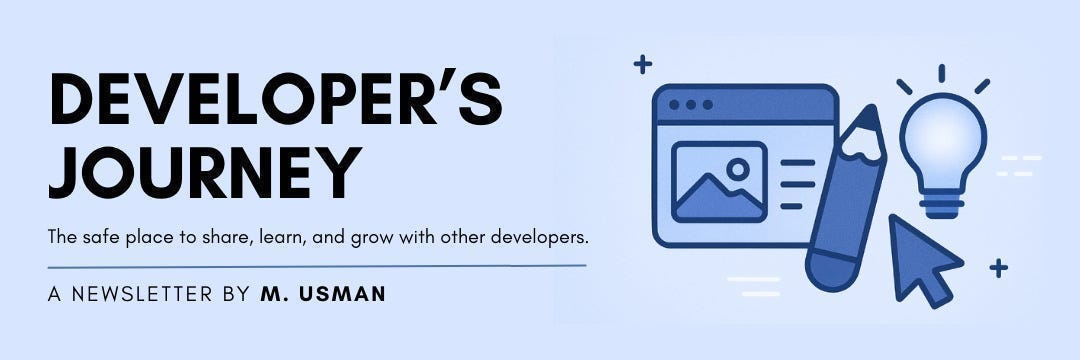Why 99% of AI Startups Will Be Dead by 2026: The 5 Death Patterns Killing AI Businesses
That’s not me. That’s statistics. And the Six Factors That Separate Winners
If you’re building an AI business right now, you’re statistically doomed to fail. Harsh? Maybe. Honest? Absolutely. I’ve gone deeply into AI business failures, MIT reports, VC analyses, corporate post-mortems, and the painful stories of companies that burned through millions. What I found is alarming and, frankly, surprising:
MIT data shows 95% of AI pilot projects fail to deliver any measurable ROI.
Tens of billions have been poured into enterprise AI with minimal returns.
Around 42% of companies are abandoning their AI projects, a number that has roughly doubled from last year.
Leading VCs estimate ~85% of AI startups fail within their first three years, higher than the general startup failure rate.
Everyone is selling the AI dream, “Build an AI business and get rich quick.” The math and the data don’t care about dreams. The real question is not whether AI companies will fail, but why yours might, and what the surviving 10% do differently. Below, I explained the exact death patterns that kill 90% of AI ventures, and the countermeasures used by the winners.
Follow and Subscribe:
| Substack | Medium | The Conversion Brief | Community: Dev Community | Bluesky | LinkedIn | Hackernoon |
The Five Death Patterns (what kills most AI startups)
Death Pattern 1: Wrapper Syndrome
Most so-called AI companies aren’t actually AI companies. They’re just slick interfaces sitting on top of someone else’s model. A clean UI, an API call to OpenAI, result comes back done. That’s not a business, that’s arbitrage.
If your product can be cloned by a student over the weekend, you don’t have defensibility.
The second the API provider ships that feature themselves, changes pricing, or tweaks the terms of service, your “company” disappears. No moat, no margin, and an inevitable race to the bottom.
Death Pattern 2: Solutions Chasing Problems
This is the classic trap: fall in love with the tech first, then scramble to find a problem worth solving. “ChatGPT is incredible… now what do we build?” That logic creates cool demos that nobody actually needs.
If you can’t explain the value in a single sentence that a 12-year-old would get, you don’t have clarity, you have complexity dressed up as innovation. The companies that last always start with a painful, expensive problem and then use AI as the lever, not the other way around.
Death Pattern 3: The Unit Economics Spiral
Here’s the math that kills, inference costs, API fees, infrastructure, support, and CAC. Add it up, and if your cost per customer is $50–$75 while you charge $29, you’re upside down from day one.
Negative unit economics only get worse with scale. Every new customer deepens the hole. And the myth of “we’ll fix it later at scale” rarely works when the per-user economics are broken at the core.
Death Pattern 4: The Implementation Gap
Demos are easy. Production is hard. In a clean sandbox, AI looks magical. In the real world, customer data is messy, systems are legacy, workflows are political, and humans resist change.
That “quick integration” often turns into 12–18 months of custom engineering, data cleanup, and organizational change. Many pilots never graduate to production because founders underestimate just how much heavy lifting it really takes.
Death Pattern 5: Misreading the Market
Buyers aren’t as ready as you think. Most are skeptical, confused, or outright scared of AI. Which means you’re not just selling, you’re educating. And education drives up CAC and stretches sales cycles.
Early adopters exist, but they’re smaller in number and already getting saturated. If you haven’t budgeted for market education, long sales timelines, and the trust-building work that comes with it, you’re underestimating the most expensive part of your go-to-market.
The Six Success Factors (what the surviving 10% do)
Success Factor 1: Problem-First Thinking
The winners don’t start with “look what AI can do.” They start with a problem so painful it already costs the customer real money, often $10,000 a month or more. They measure the limits of today’s solution, then design an AI fix that’s clearly better and back it with ROI numbers. AI is just the tool, the problem you’re solving is the value.
Success Factor 2: Proprietary Data Advantage
The only true moat in AI is data. Public APIs are copy-paste. Proprietary datasets are not. The best companies lock in exclusive partnerships, build unique collection methods, or create network effects that make their models better over time in ways competitors can’t replicate. That’s where defensibility lives.
Success Factor 3: Unit Economics Discipline
Winners know their math from day one. They model inference, infra, CAC, support, churn the whole picture. They optimize inference costs, cache aggressively, blend models when it makes sense, and price for profit at every customer tier. And they can tell you their profitability at 100 customers, 1,000 customers, and a million.
Success Factor 4: Vertical Specialization
Generalists fight on price, specialists win on value. Focused AI companies dominate a single vertical law firms, real estate, e-commerce, medical imaging, and win because they can charge more, build features that matter, and shorten sales cycles by speaking the customer’s exact language.
Success Factor 5: Human + AI Collaboration
The smart companies don’t try to replace people, they make people better. Human-in-the-loop designs increase trust, reduce fear, and deliver stronger results because humans bring context and judgment the AI can’t. Adoption follows the tools that amplify humans, not the ones that threaten them.
Success Factor 6: Sustainable Tech Stack
The winners always play the long game on tech. They use open-source when it makes sense, mix models strategically, and architect systems to keep inference costs low while staying flexible. Winners always plan for provider risk, pricing changes, downtime, and new disruptive models. In other words, they don’t get locked into one vendor, and they don’t get caught flat-footed.
Action Plan: How to Join the 10%
Step 1: Problem Validation
Boil the problem down to one sentence. If you can’t, it’s not clear enough. Then ask: does this problem cost the customer at least $10k a month? Are they already hunting for solutions? Can you prove ROI with hard numbers? If the answer’s no, you’re solving the wrong thing.
Step 2: Unit Economics Reality Check
Do the math. What are your real inference costs, infra costs, CAC, and LTV? Are you actually profitable per customer right now, or are you subsidizing usage and calling it growth? If the math doesn’t work, nothing else matters.
Step 3: Competitive Edge Test
What do you own that nobody else can copy quickly? Proprietary data, distribution, capability, something. If a rival can replicate you in a quarter, you don’t have an edge, you have a head start. That’s not defensible.
Step 4: Tech Stack Audit
Are you chained to a single provider? What happens if they raise prices, go down, or roll out your feature themselves? Have you optimized for cost vs. performance? Do you have a backup plan? Vendor lock-in kills more quietly than churn, but just as surely.
Step 5: Market Focus Check
Are you trying to sell to everyone? If so, you’re too broad, narrow it down. Pick a vertical where you can charge a premium, speak the customer’s language, and still have room to grow. Big enough market, not already saturated. That’s where you win.
Quick Red Flags (course-correct now if you see these)
Unit economics worsen as you scale.
CAC (Customer Acquisition Cost) rising faster than revenue.
Implementation cycles longer than expected.
Monthly churn > 5%.
You can’t explain your value to a 12-year-old.
Competitors launch similar features weekly.
You’re constantly forced to compete on price.
Customers require heavy handholding to realize value.
Not my Final Word
This isn’t to say the AI revolution isn’t real, it absolutely is. The opportunities are massive. But success requires more than packaging an API behind a pretty UI. It requires starting with real problems, mastering economics, building defensible data moats, specializing in real markets, and designing products that make humans better.
If you’re serious about building an AI business and want tactical help, or want to avoid the mistakes that kill 90% of ventures, there are practical playbooks and communities that do the heavy lifting validation frameworks, unit economics templates, and vertical GTM (Go-To-Market) scripts.
I’d rather tell you the hard truth now than watch you waste years and money on something destined to fail. Build for the long term solve expensive problems, and prove ROI (Return on Investment), that’s how you join the 10%.
Did you learn something good today?
Then show some love. 🫰
©
WordPress Developer | Website Strategist | SEO Specialist
Don’t forget to subscribe to Developer’s Journey to show your support.
Available for freelance projects on Upwork






